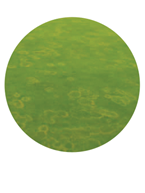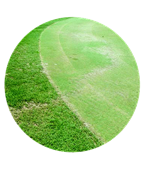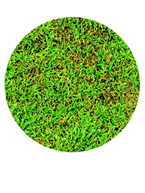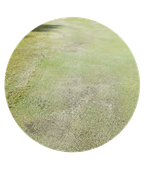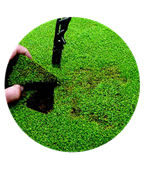The Problem
Pink, gray, and speckled snow molds are devastating turf diseases that occur on golf course putting greens, tees and fairways in the presence of snow cover. These diseases are not only unsightly in the spring, but can leave the turf surfaces unplayable and open to weed infestation. Both pink and gray snow molds can affect all cool-season turfgrasses, but tend to be more problematic on annual bluegrass and bentgrasses.
What To Look For
Pink and speckled snow mold, caused by Microdochium nivale, occurs in cold, wet weather (32-50°F) with intermittent periods of snow cover (less than 60 days). Symptoms are visible at snow melt as tan patches 2-12 inches in diameter with a pink border. The affected areas change in color to a whitish-gray, with leaves taking on a bleached appearance. Individual patches may coalesce, resulting in extensive damage to the turf.
Gray snow mold, caused by Typhula sp., is active at 32-40°F with extended snow cover (greater than 80 days). Symptoms appearing at snow melt are light yellow to gray discolored areas ranging from 3-12 inches or more in diameter. Matted turf progresses quickly to a grayish-white color. As patches enlarge, a 1-inch halo of grayish-white mycelial growth can appear at the surrounding margin. Individual patches may coalesce to form large affected areas. The key diagnostic feature is the presence of small, round, hardened sclerotia (chestnut-brown for gray snow mold (Typhula incarnata) and black for speckled snow mold (Typhula ishikariensis)). Pink snow mold can be distinguished from gray and speckled snow mold by the absence of these characteristic sclerotia.
The Solution
Implementing proper cultural practices will reduce severity. Management strategies include avoiding late fall fertilization that leads to lush growth, controlling excessive thatch, removing tree leaves from the turf, controlling drifting snow and removing snow/improving drainage to promote rapid drying in early spring.
A pre-snow preventive application is critical for protecting vulnerable turf areas from snow mold. While disease symptoms develop under snow cover, sclerotia begin to germinate in the fall at 50-65°F. An additional (primer) application during this time period has been shown to reduce disease severity the following spring. After your last mowing of the season, but prior to snow cover, a final fungicide application is needed. Products or mixtures containing 2-3 different active ingredients have been shown to provide exceptional snow mold control.
Interface® Stressgard® is the ideal treatment for the management of pink and gray snow mold. It can be used alone as the foundation for a strong Microdochium patch/pink snow mold program, or in combination with Mirage® Stressgard for long-lasting protection against pink, gray, and speckled snow molds. Densicor® can also be used for the primer snow mold application 2-3 weeks prior to the final application, in the primary snow mold application, and/or for clean up of late snow mold or Microdochium in the spring.
Multiple years of research have shown that Stressgard products provide excellent disease control and improved turf quality following snow melt in the spring. As with any snow mold fungicides, if treated areas are subject to abnormal weather, heavy rainfall and/or snowfall that melts prior to permanent snow cover, a repeat application may be necessary to provide adequate snow mold protection.
Additional resources
| Solution sheet - Snow mold |






